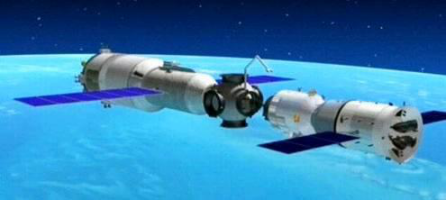Full coverage: China Breakthroughs
By Tom McGregor, CCTV.com Panview commentator and editor
Space remains the 'final frontier' for our world and Beijing is exploring new ways to journey beyond Earth's atmospheric boundaries. Yet in addition to a spirit of adventure, jetting off into orbit has led to major advances for science and technology that have transformed our daily lives. Consequently, Chinese companies are boosting investments and R&D (Research & Development) support for the satellite technology industry.

Tiangong-1 space lab
The China National Space Administration (CNSA) has taken charge of the space program in the country and has signed agreements with other countries to share technologies and information. In recent years, Beijing has made remarkable progress in the 'space race.' Currently, more than 130 China-made spacecraft and satellites are in orbit. CNSA recognizes that its team must rely on cooperation from other nations abroad in order to flourish.
Belgium joins China for Earth Observation mission
Beijing and Brussels approved in July 2015 a MOU (memorandum of understanding) for joint collaboration on satellite technology that could place both nations "at the forefront" to deliver vital information worldwide, as revealed by Belgian State Secretary of Science Policy Elke Sleurs. The document was signed by the Belgian Federal Science Policy Office (BELSPO) and CNSA to support space sciences, technologies and applications.
The key project include the Earth Observation program, a satellite mission. Space agencies from both nations plan to design and build a satellite with the full capacity to deliver exclusive agriculture and environmental information to the rest of the world.
"We have been building on the scientific cooperation between Belgium and Chinese scientists over the past few years, especially in the fields of the application of Earth observation data for environmental monitoring, "Sleurs told Xinhua News Agency." The idea grew to also involve technological and industrial partners in the cooperation."
New advances for the next space age
Through collaboration of rocket scientists from around the globe, China is making tremendous advances on space propulsion technology. CNSA hopes to launch a communications satellite that utilizes electric propulsion.
Wang Min, a satellite designer from the Chinese space academy, explained that using such technology can cut in half the energy requirements for a space launch, while reducing the costs of launching a satellite into space by 30 percent.
Meanwhile, there is even bigger news in regards to recent advancements in space technology. Wang Feixue, director of the Center for Satellite Navigation and Positioning Technology, has been leading China's Beidou Satellite System, a team of 300 scientists, to enhance global satellite coverage by 2020.
"The Beidou global system will focus on upgrading precision and expanding its application in the Asia-Pacific region," Wang told China Daily. He described how Beidou would be a much more advanced version of GPS (Global Positioning System), which can pinpoint an object on Earth from satellite imagery within 1.5 meters at a given point, instead of the current range of 10 meters.
Nigeria goes to orbit with China
Nigerian scientists are also pursuing opportunities to work with China to jumpstart its satellite communications technology development. Abimbola Alale, managing director of the Nigerian Communications Satellite (NigComSat), and China's former ambassador to Nigeria Gu Xiaojie have pledged further support for bilateral scientific collaboration.
Space technology experts from China's Great Wall Corporation will be assigned to work inside NigComSat facilities in Abuja, as reported by AllAfrica news Website. The NigComSat is scheduled to be the first satellite station to be launched by China in the African continent.
Long March rockets launch into space
The CNSA has developed a family of rockets, Long March series, which have launched into space. Some launches were success stories while also a few sputtered as failed missions.
The overall objective is for Long March rockets to carry payloads and satellites in outer space to conduct experiments, build a space station, as well as deploy and integrate new satellite technologies.
For-the-record, as reported by ECNS (English-language China News Service) on Sept. 29, 2017, "China used a Long March 2C carrier rocket that day to lift three satellites, indicating the nation has resumed its space launches after a major failure in July."
ECNS added, "The rocket blasted off in the afternoon at the Xichang Satellite Launch Center in Sichuan Province, successfully placing three Yaogan 30-1 satellites into orbit, according to a news release from China Aerospace Science and Technology Corp, the major contractor of the country's space programs."
Global values bridging China's space dreams
Despite some setbacks, Beijing stands "at the forefront” as a world leader for the future of satellite communications technology, but Chinese scientists cannot achieve success alone. They need the assistance of scientists from all over the globe.
Accordingly, CNSA is taking a proactive approach to sign cooperation agreements with space agencies from other countries. Such collaboration would provide a more innovative attitude as the Chinese Dream continues to skyrocket in space.
Tmcgregorchina@yahoo.com
(The opinions expressed here do not necessarily reflect the opinions of Panview or CCTV.com. )

Panview offers a new window of understanding the world as well as China through the views, opinions, and analysis of experts. We also welcome outside submissions, so feel free to send in your own editorials to "globalopinion@vip.cntv.cn" for consideration.
















